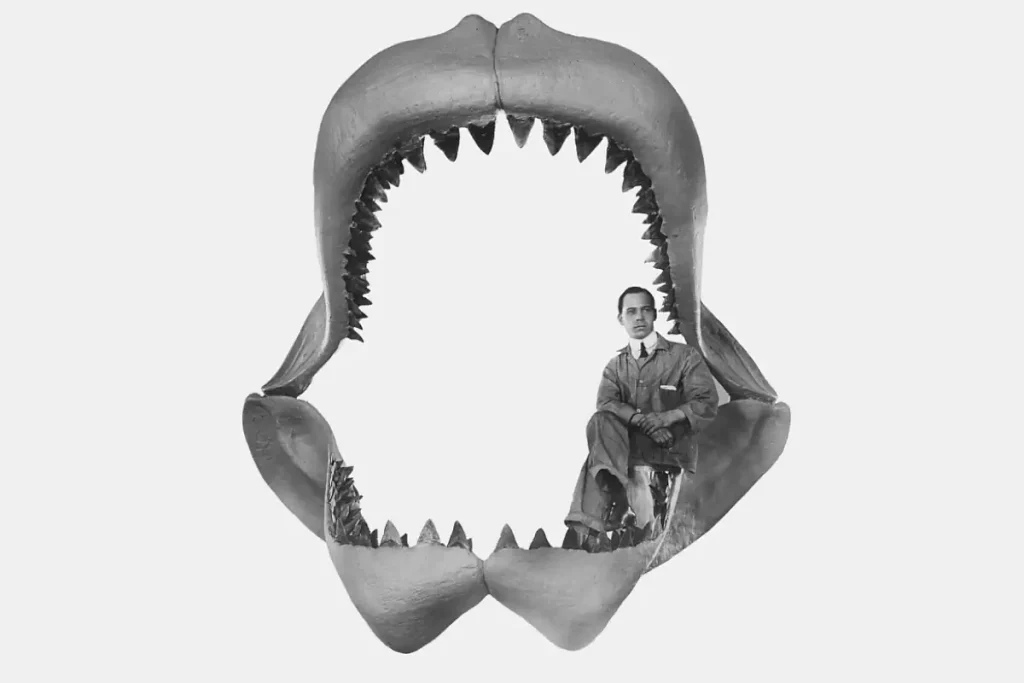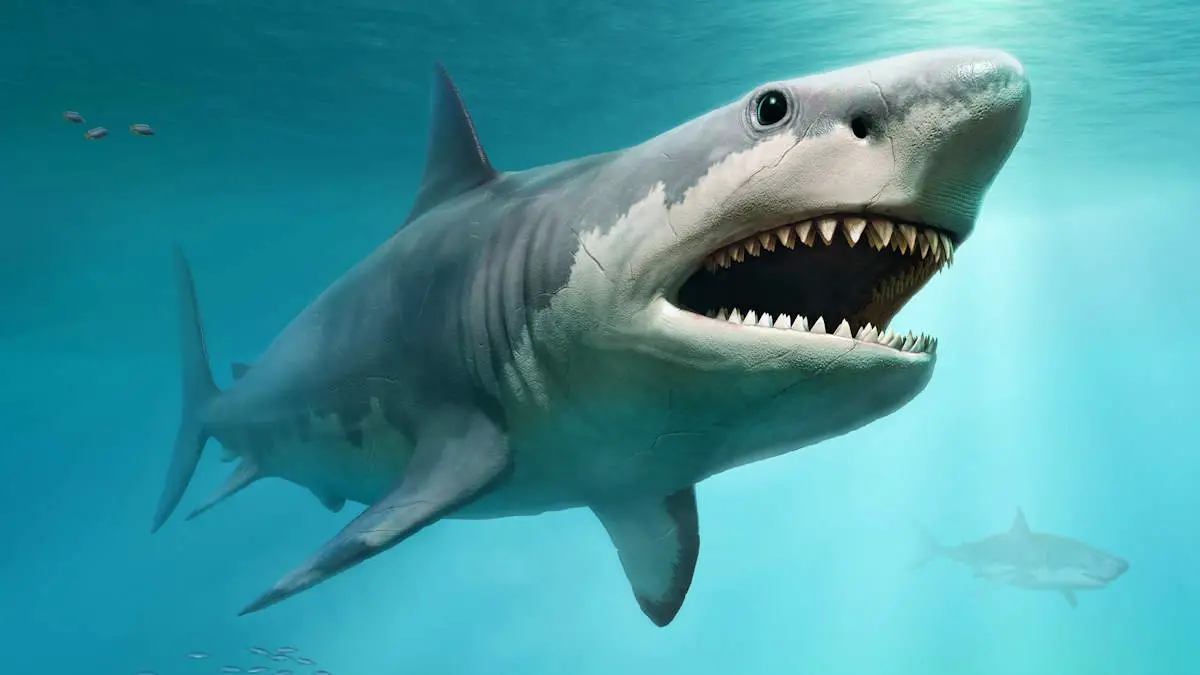The ancient seas once teemed with the terrifying presence of Otodus megalodon – the largest shark species ever known. This prehistoric predator, commonly called the Megalodon, thrived approximately 23 to 3.6 million years ago during the Early Miocene to the Pliocene epochs. As the largest predatory fish in history, it dominated the oceans. But just how big was the Megalodon?
Unearthing the actual size of this extinct marine behemoth has been a challenge for scientists due to the limited fossil records, which predominantly include teeth and vertebrae. The great white shark considered the closest living relative of the Megalodon, is often used as a reference point in size estimations.
As an apex predator, the Megalodon played a crucial role in shaping the marine ecosystems of its time. Its gargantuan size, coupled with its hunting prowess, placed it at the pinnacle of the oceanic food chain. However, determining its actual dimensions remains a topic of extensive scientific debate, due to the inconsistency and limitations of the available fossil evidence.

How big was the Megalodon?
Unraveling the true size of the prehistoric megalodon has been a point of continuous debate among researchers, primarily due to the paucity of intact remains. There are only fragmented remnants of the gargantuan shark – fossilized teeth and vertebrae. These sparse remnants have led to numerous conflicting size estimates over the years. As explained above, in the unfortunate absence of a complete specimen, the modern great white shark, which is considered the most comparable living species, has served as the benchmark for size estimations.
Early Reconstruction Attempts and Theories
The first endeavor to understand the megalodon’s size dates back to 1909 when the American zoologist Bashford Dean (October 28, 1867 – December 6, 1928) attempted to recreate the jaw of the ancient sea giant. Displayed at the American Museum of Natural History, Dean’s reconstruction led to the hypothesis that the megalodon could have reached an impressive 30 meters (98 feet) in length, as big as the Blue Whale!
However, Dean’s estimate was later criticized as an overestimation, attributed to his overreach in the size estimation of the jaw cartilage.

Measurement Techniques and their Controversies
In 1973, the American ichthyologist and a leading authority on coral reef fishes, John E. Randall (May 22, 1924 – April 26, 2020) introduced a novel methodology for determining the length of the megalodon – using the enamel height of a tooth. This approach suggested a maximum length of about 13 meters (43 feet). Critics of this method, however, pointed out that the height of tooth enamel does not always increase in proportion to the animal’s total length, thereby challenging the accuracy of Randall’s estimate.
In 1994, Patrick J. Schembri and Stephen Papson, marine biologists, suggested that the megalodon might have been somewhere around 24 to 25 meters (79 to 82 feet) in total length (see sources 3). They too faced similar criticisms, as the model they proposed was based on a more unreliable evaluation of dental homology between megalodon and the great white shark.
A few years later, in 1996, researchers Michael D. Gottfried, Leonard Compagno, and S. Curtis Bowman proposed a linear relationship between the height of the largest upper anterior tooth of a great white shark and the shark’s total length. Using this methodology, they estimated the megalodon’s total length at 15.9 meters (52 feet) based on a tooth 16.8 centimeters (6.6 inches) tall. Despite considering this a conservative estimate, they also utilized another model comparing tooth height to total length ratios in female great whites, leading to size estimates of 16.8 meters (55 feet) to 20.2 meters (66 feet) (See sources 4).
New Perspectives in the 21st Century
By the turn of the century, the quest to determine the true size of the megalodon remained. In 2002, shark researcher Clifford Jeremiah proposed that the total length of a megalodon was proportional to the root width of an upper anterior tooth. According to Jeremiah, for every 1 cm of tooth root width, there are approximately 1.4 meters of shark length. By this method, the largest tooth in Jeremiah’s possession, which had a root width of about 12 cm, suggested a total length of 16.5 meters (54 feet) (See sources 5).
In the same year, paleontologist Kenshu Shimada challenged previous methodologies and proposed a linear relationship between tooth crown height and total length, which could be applied to teeth of any size. Shimada’s approach resulted in a size estimate of 15 meters (49 feet) based on a particular upper anterior tooth. He also used an upper lateral tooth found in the Gatún Formation of Panama to suggest a size of 17.9 meters (59 feet) (See sources 6, 7).
In 2019, Shimada revisited the size of the megalodon and discouraged using non-anterior teeth for estimations, noting the difficulties in identifying the exact position of isolated non-anterior teeth. Utilizing the largest anterior teeth in museum collections, Shimada came up with a maximum total length estimate of 14.2 meters (47 feet) to 15.3 meters (50 feet).
The Latest Developments in Megalodon Size Estimations
Fast forward to 2021, researchers Victor J. Perez, Ronny M. Leder, and Teddy Badaut proposed a new method for estimating the total length of a megalodon: by adding the widths of tooth crowns. They noted that the 2002 Shimada crown height equations led to vastly different results for different teeth from the same shark, thereby questioning the conclusions of previous studies using that method. Their method, using the largest tooth with a crown width of 13.3 centimeters (5.2 inches), suggested a maximum body length of approximately 20 meters (66 feet), an estimate supported by subsequent research in 2022 (See resources 8, 9).
Extraordinary Large Megalodon Specimens and Anecdotal Evidence
Beyond scientific estimations and formal collections, anecdotal reports suggest the existence of even larger megalodon teeth. One of the most significant examples is held by Gordon Hubbell from Gainesville, Florida, who owns an upper anterior megalodon tooth measuring an astonishing 18.4 centimeters (7.25 inches) in height. Additionally, a megalodon jaw reconstruction by fossil hunter Vito Bertucci features a tooth reportedly over 18 centimeters (7 inches) in height, further tantalizing us with the prospect of a much larger megalodon than previously estimated.
In conclusion, although the exact size of the megalodon remains a point of contention among researchers, it is undeniable that the creature was an imposing figure in the Earth’s prehistoric seas. As research continues and more fossil evidence is hopefully unearthed, our understanding of this magnificent creature will only continue to grow.
Weight Estimations of Megalodon
Estimates drawn from the dimensions of vertebral centra, mirroring those of a great white shark, suggest that a megalodon could have impressive sizes and weights. A 16-meter-long (52 feet) individual could weigh as much as 48 metric tons (53 short tons), a 17-meter-long (56 feet) individual could reach 59 metric tons (65 short tons), and the maximum recorded length, 20.3 meters (67 feet), could correspond to a weight of up to 103 metric tons (114 short tons).
However, a different approach utilizing a 3D model based on the vertebral columns of all existing lamnid sharks suggests even greater possible dimensions. A megalodon of 16 meters (52 feet) could potentially exceed previous estimates, reaching over 61.5 metric tons (67.8 short tons) in body mass. To sustain such a massive body, an individual of this size would require a daily intake of 98,175 kilocalories.
Megalodon’s Incredible Bite Force
In 2008, S. Wroe spearheaded a scientific experiment aimed at estimating the great white shark’s bite force, using a specimen measuring 2.5 meters (8.2 feet) long. The team then scaled up these results to deduce the potential bite force of the enormous megalodon, taking into account the creature’s conservative minimum and maximum body mass.
The team estimated the megalodon’s bite force to be a staggering 108,514 to 182,201 newtons (24,395 to 40,960 lbf) in a posterior bite. For perspective, the bite force of the largest confirmed great white shark stands at 18,216 newtons (4,095 lbf), and the prehistoric placoderm fish, Dunkleosteus, had a bite force of 7,495 newtons (1,685 lbf).
The team also suggested that the force experienced by prey could be higher than their estimates, given sharks’ tendency to shake sideways while feeding, thereby amplifying the force generated.
An insightful study in 2021 led by Antonio Ballell and Humberto Ferrón utilized Finite Element Analysis modeling to explore the stress distribution of megalodon teeth and those of related mega-toothed species under anterior and lateral forces. Such lateral forces would arise when a shark shakes its head vigorously to tear through its prey.
Their simulations revealed that megalodon teeth underwent higher levels of stress under lateral force loads compared to its predecessor species like O. obliquus and O. angusteidens when tooth size was factored out.
These findings imply that megalodon teeth might have served a different functional role than previously surmised, challenging earlier interpretations that linked the creature’s dental morphology primarily to a dietary shift towards marine mammals. Instead, the researchers proposed that the megalodon’s unique dental features might have been a byproduct of an increase in body size induced by heterochronic selection.
The remarkable attributes of the megalodon’s teeth and its unparalleled bite force offer intriguing insights into the life and behaviors of this colossal prehistoric predator. Further exploration of these characteristics will undoubtedly shed more light on the fascinating story of the megalodon, contributing to a richer understanding of Earth’s natural history.
Sources
- Megalodon on Wikipedia
- Turns Out The Megalodon Shark Ain’t THAT Big on the Forbes website
- Otodus megalodon (Agassiz, 1843) on gbif.org
- Gottfried, MD; Compagno, LJV; Bowman, SC (1996). “Size and skeletal anatomy of the giant megatooth shark Carcharodon megalodon” San Diego, California: Academic Press.
- Megalodon: Hunting the Hunter. Paleo Press, 2002.
- “Ancient Nursery Area for the Extinct Giant Shark Megalodon from the Miocene of Panama”. Catalina Pimiento, Dana J. Ehret, Bruce J. MacFadden, and Gordon Hubbell. Link
- Pimiento, Catalina; Gerardo González-Barba; Dana J. Ehret; Austin J. W. Hendy; Bruce J. MacFadden; Carlos Jaramillo (2013). “Sharks and Rays (Chondrichthyes, Elasmobranchii) from the Late Miocene Gatun Formation of Panama” PDF
- Perez, Victor; Leder, Ronny; Badaut, Teddy (2021). “Body length estimation of Neogene macrophagous lamniform sharks (Carcharodon and Otodus) derived from associated fossil dentitions”. Palaeontologia Electronica. 24 (1): 1-28. Palaeontologia Electronica
- Cooper, J.A.; Hutchinson, J.R.; Bernvi, D.C.; Cliff, G.; Wilson, R.P.; Dicken, M.L.; Menzel, J.; Wroe, S.; Pirlo, J.; Pimiento, C. (2022). “The extinct shark Otodus megalodon was a transoceanic superpredator: Inferences from 3D modeling”. Science Advances. 8 (33): eabm9424.
- Moon Landings: All-Time List [1966-2025] - February 2, 2025
- What Is Max-Q and Why Is It Important During Rocket Launches? - January 16, 2025
- Top 10 Tallest Rockets Ever Launched [2025 Update] - January 16, 2025


